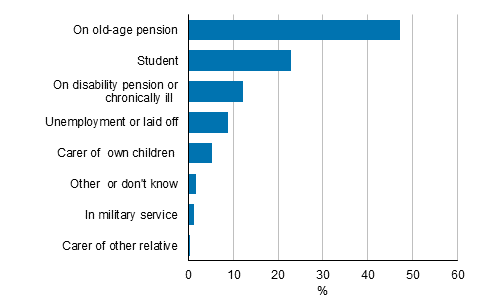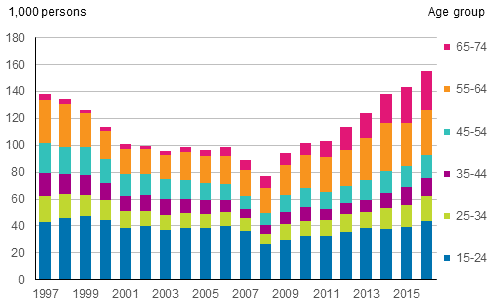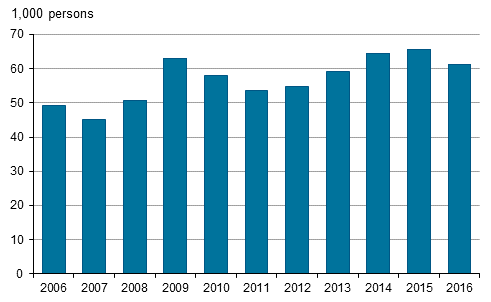4 Inactive population
4.1 Share of inactive population 35 per cent in 2016
In 2016, there were 1,424,000 persons in the inactive population, or 35 per cent of persons aged 15 to 74. The number was 11,000 higher than in 2015. In the Labour Force Survey, the inactive population refers to persons who were not employed or unemployed during the survey week.
The Labour Force Survey also collects data on what the persons in the inactive population see as their principal activity. A majority of the inactive population, approximately 60 per cent, reported that they were on old-age or disability pension or chronically ill. The small growth in the number of the inactive population is precisely due to the growing number of persons on old-age pension.
Slightly under one-quarter of the inactive population reported that they were full-time students or pupils. Of the inactive population, close on one-tenth reported that they were unemployed or laid off but were not classified as unemployed in the Labour Force Survey. Around six per cent were caring for their own children or some other relative. (Figure 20.)
Figure 20. Persons in the inactive population by main activity* in 2016, persons aged 15 to 74, %

Data concerning main type of activity are based on the respondent's own reporting.
4.2 Number of persons in disguised unemployment continued growing
Persons in the inactive population who would want gainful work and would be available for work within a fortnight, but who have not looked for work in the past four weeks are considered persons in disguised unemployment in the Labour Force Survey. Persons in disguised unemployment can be considered as potential additional labour force.
There were a total of 155,000 persons aged 15 to 74 in disguised unemployment in 2016, up by 11,000 from the year before. The number of persons in disguised unemployment rose for the second year to the highest level since disguised unemployment has been reported starting from 1997. The number of persons in disguised unemployment has grown steadily since 2008, when the number was at its lowest, 77,000 persons. Compared with the year before, the youngest and oldest age groups of all had especially grown. (Figure 21.)
The assumption that no work is available was the most common reason among persons in disguised unemployment for not seeking employment. This was believed by good one-quarter of persons in disguised unemployment. For around one-fifth, the reason was studying and for one-tenth that they had started full pension.
In 2016, like in previous years, most persons in disguised unemployment were found in the age group 15 to 24, in total 44,000 persons. A majority of them mentioned studying as the reason for not seeking employment. They were thus students who wanted work (besides studies), but had not looked for it. There were 34,000 persons in disguised unemployment among the age group 55 to 64 of whom nearly one-half had not sought employment because they did not believe work was available.
In the age group 65 to 74, the number of people in disguised unemployment has increased during good ten years from a few thousand to the current 29,000 persons. The majority of those aged 65 to 74 in disguised unemployment had not looked for work because they had started full pension or because they believed work was not available.
Figure 21. Persons in disguised unemployment by age group in 1997 to 2016

4.3 Ten per cent of young people outside work and education
There are a great number of full-time students among unemployed young people who are seeking, for example, part-time employment during studies or work during summer holidays. For this reason, in addition to youth unemployment, young people aged 15 to 24 outside work and education and their share of age group, or the NEET rate (Not in Employment, Education or Training) have also been monitored in recent years. This Section describes young people who are not employed and have not participated in any type of education in four weeks before the Survey and who are not performing compulsory military service either. Here, participation in education refers to both education leading to a qualification and participation in various types of courses.
In 2016, there were a total of 61,000 young people not working, studying or performing compulsory military service, which represented 10 per cent of the entire 15 to 24 age group (Figure 22). The number of young people outside work and education fell for first time since 2011. Nevertheless, their relative share in the age group remained the same (10%) because the size of the age group decreased slightly compared with the previous year.
Figure 22. Young people aged 15 to 24 who were not working, studying or performing compulsory military service in 2006 to 2016

Around one-half of young people outside work and education were men and one-half women. About 60 per cent of them considered themselves unemployed in 2016. Around 16 per cent reported that they were on disability pension or chronically ill. About one in ten were caring for their children.
Thus, the majority of young people outside work and education consider themselves unemployed or unable to work. However, being outside work and education is not always a problem for young people. The number of young people outside work and education has been highest during summer and at the turn of the year, which partially suggests that for many this is a short period during which they prepare for entrance examinations, take a holiday, or wait in between studies, work or compulsory military service.
Being outside work and education is more common for those aged 20 to 24 than for those aged 15 to 19. Study for entrance examinations or take compulsory military service after the upper secondary general school or vocational school is common at the age from 20 to 24. However, around every third young person aged 20 to 24 outside work and education in 2016 had not yet completed an upper secondary level qualification.
Source: Labour Force Survey 2016. Statistics Finland
Inquiries: Hanna Sutela 029 551 2907, Liisa Larja 029 551 3461, tyovoimatutkimus@stat.fi
Director in charge: Jari Tarkoma
Updated 12.4.2017
Official Statistics of Finland (OSF):
Labour force survey [e-publication].
ISSN=1798-7857. Time series data 2007-2016 2016,
4 Inactive population
. Helsinki: Statistics Finland [referred: 27.12.2025].
Access method: http://stat.fi/til/tyti/2016/13/tyti_2016_13_2017-04-12_kat_004_en.html

